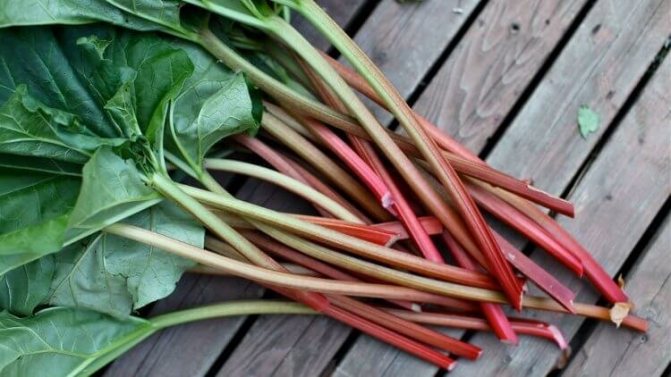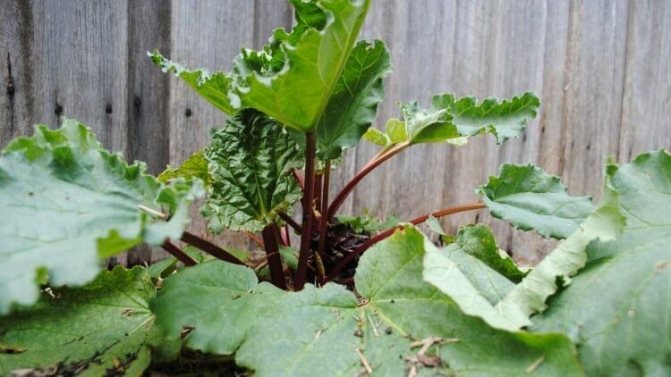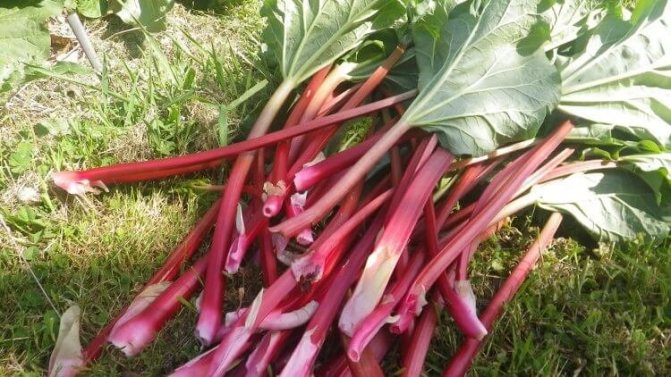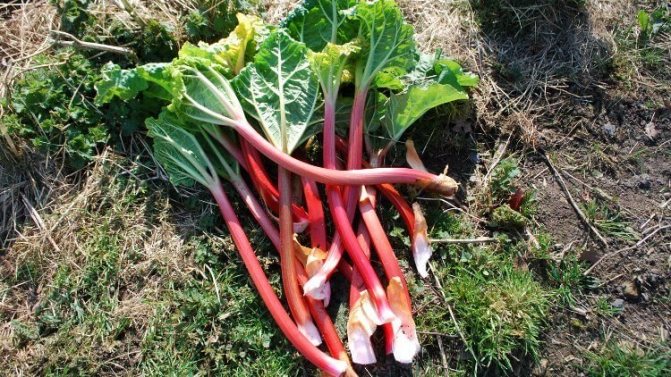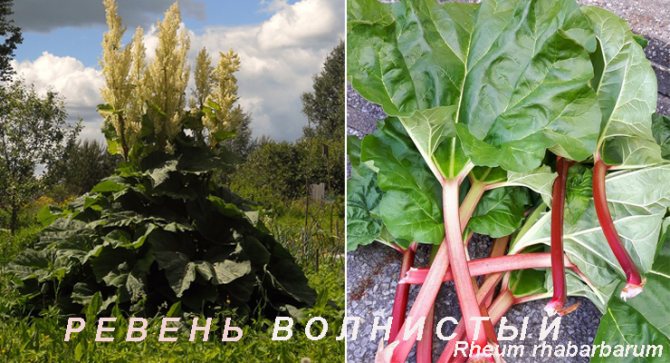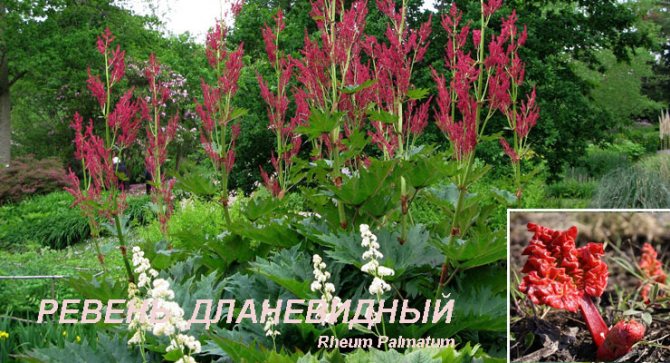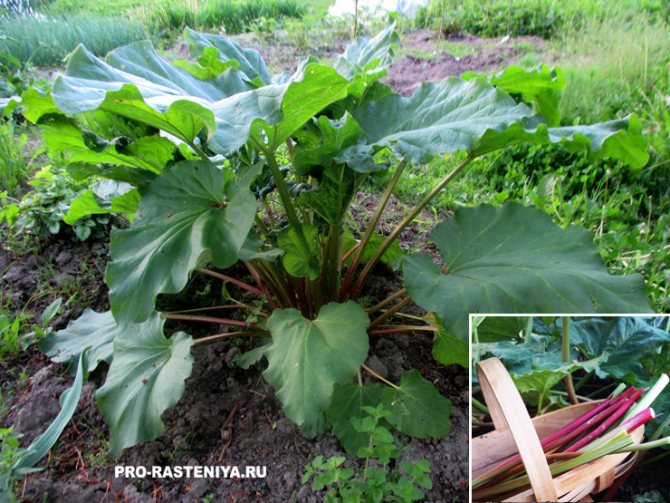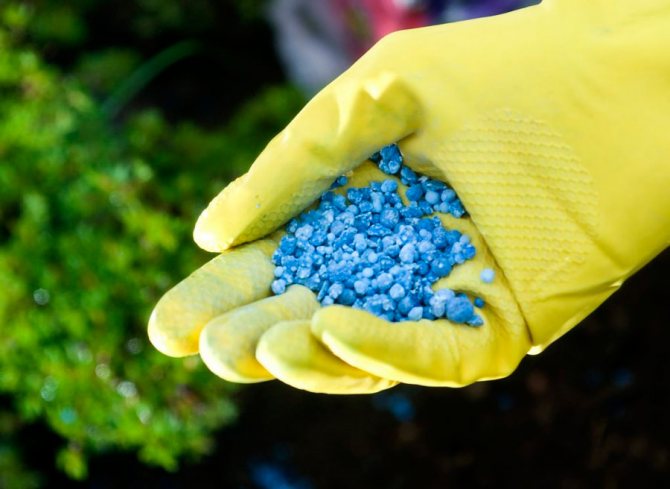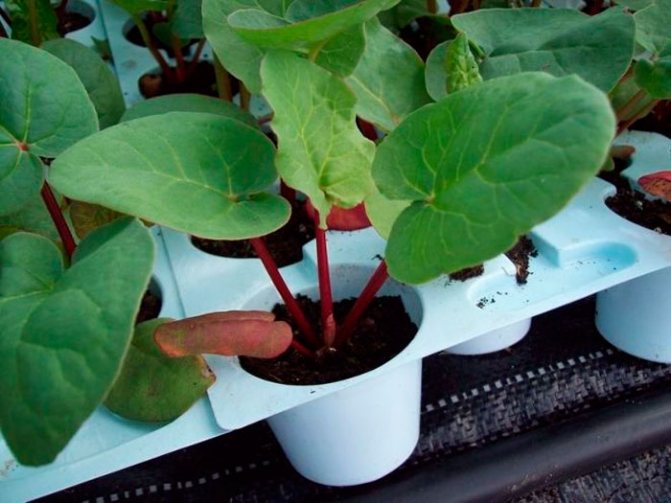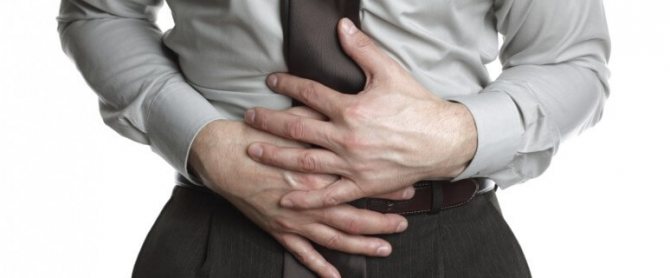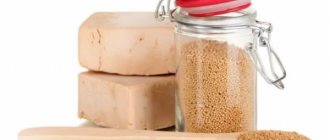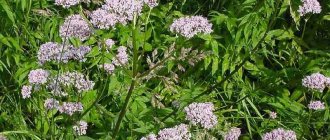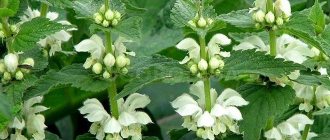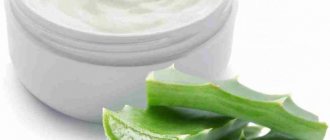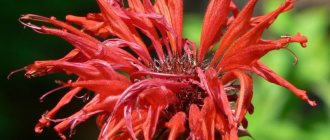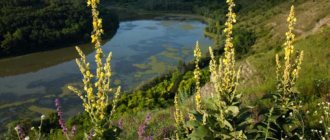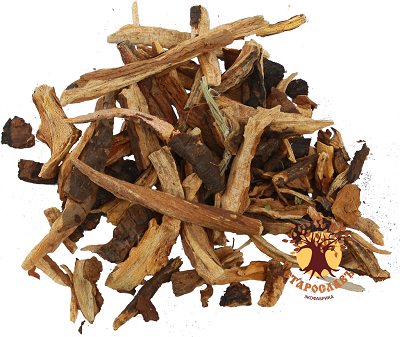
Latin name: Rheum altaicum Losinsk
A perennial herb from the buckwheat family, up to 2 m high, with a short, thick, many-headed rhizome, from which fleshy succulent roots extend. Basal leaves are rounded-ovate, deep-heart-shaped at the base, large, long-petiolate, stem ovate, alternate, with a dry filmy bell at the base. In the second - third year of life, small, regular, pink, white or green flowers appear, collected in large paniculate inflorescences. Fruits are red-brown triangular nuts with wings. Blooms in July.
It is found in tall-grass forest and subalpine meadows, in herbaceous woodlands, in coniferous and mixed forests, among shrubs in the forest and subalpine zones of the south of Western Siberia.
Tangut rhubarb (Rheum palmatum var. Tanguticum Maxim), found in natural conditions only in the northern provinces of China, is successfully cultivated on household plots, as well as on the plantations of the Moshkovsky state farm of medicinal plants located in the Novosibirsk region.
For medicinal purposes, the roots and rhizomes of Rhubarb 3-4 years of age, which are harvested in the fall, are used.
Rhizomes and roots contain anthraglycosides, tannoglycosides (tannins of the pyrocatechol group and derivatives of gallic acid), which have an astringent effect. Leaves - substances of P-vitamin action, malic, citric, oxalic, ascorbic acids, sugars, ergosterol, salts of iron, potassium, magnesium, phosphorus, protein.
Rhizome and root preparations are used as a regulator of the gastrointestinal tract. In small doses, they are astringent, and in large doses, a mild laxative effect. In addition, Rhubarb preparations increase appetite, improve digestion, have choleretic and antiseptic properties. Indicated for poor appetite, gastritis, chronic enteritis, colitis, dyspepsia, constipation, intestinal atony, rectal fissures, hemorrhoids. The rhizomes and roots of the plant are part of a complex bitter tincture, gastric and choleretic charges. From them, the drug chrysarobin was obtained, which was proposed for the treatment of psoriasis.
In folk medicine, Rhubarb roots are used for various disorders of the gastrointestinal tract, liver and biliary tract diseases, stomach catarrh with low acidity, intestinal inflammation, jaundice, anemia, tuberculosis. Powder of dry root is sprinkled on wounds and burns. For medicinal purposes, the most suitable roots and rhizomes of 3-4 years of age.
The effectiveness of Rhubarb preparations decreases with prolonged use.
Used plant parts
- Root
Description of the plant
The plant is found not only in the wild, but is also cultivated for home use in personal plots, as well as on specialized plantations for medicinal and food production.
The birthplace of rhubarb is the central part of China, from which the plant spread throughout the world. Rhubarb loves fertile and moist soils. The plant requires a sufficient amount of sunlight for normal vegetation. Rhubarb grows on the territory of Kazakhstan, it is found in the West of Siberia. The plant is cultivated in the Altai Territory. Distributed in the territory of the CIS countries.
Morphological characteristics
Despite the height of rhubarb (about 3 m), it is classified as a perennial herb. The large size of the leaves allows it to be used to decorate private garden plots. The description of the parts of the plant is as follows.
- Root. The root system of rhubarb is represented by a short rhizome, from which long roots extend, which absorb moisture. The rhizome is multi-headed, covered with dark brown bark. As a rule, it is small in size. But the roots are very long, deeply penetrating into the soil. Powerful and fleshy, they are yellowish in color. Harvested together with rhizomes.
- Stem. It has an impressive diameter - about 5 cm. Naked, erect, it branches slightly upward. The upper part of the stem ends with an inflorescence. There are reddish spots on the smooth surface.
- Leaves. Basal rosettes of leaves provide large volumes of the plant, because large leaf plates, reaching a length of 75 cm, sit on petioles - up to 1.5 m long. The petiole of a cylindrical shape may have a slightly grooved surface, as well as red spots on it. The leaves are pubescent below with long hairs, attached to the petiole with a heart-shaped base. Leaf shape is broadly ovate. The edge is wavy or coarsely cut. The end of the sheet is pointed. Stem leaves are alternately attached to the stem using short petioles with a wide bell. The size of the stem leaves is much smaller than the basal ones.
- Flowers. The paniculate rhubarb inflorescence is located at the very top of the stems. It is formed by small flowers, pinkish-white or red in color. Corollas eventually fall off (soon after pollination of the flower). Rhubarb bloom begins in June.
- Fruit. Nuts are small in size, not exceeding 1 cm. Each fruit has three sides and wide lionfish for better distribution. Fruit ripening begins in July, and ends completely by the month of August.
Reproduction of rhubarb occurs with the help of seeds that germinate well, immediately after getting into favorable conditions - warm, moist, fertile soil.
What does the aboveground part contain?
Rhubarb stalks are rich in pectins, fiber, starch and sucrose. These substances are capable of:
- improve digestion;
- stimulate peristalsis;
- give the body a boost of energy;
- to increase the tone with a breakdown.
Of the vitamins, rhubarb stalks contain vitamin K and ascorbic acid.
- Vitamin K. Improves blood clotting, prevents internal bleeding. Also, this vitamin is necessary for normal bone mineralization, absorption of calcium and vitamin D, as well as their effective interaction. In addition, vitamin K affects the permeability of the vascular wall and prevents capillary fragility.
- Ascorbic acid. The most powerful natural antioxidant, stimulator of cellular respiration and activator of immune responses.
Of the minerals, rhubarb stalks contain a large amount of silicon, as well as calcium and potassium, being an additional source of these substances for the human body.
Young petioles are rich in succinic, malic, oxalic acid. They are participants in metabolism, protect the body from free radicals, stimulate the formation, as well as the excretion of bile and urine.
Oxalic acid, exceeding the dosage of which leads to the formation of kidney stones, is found in large quantities in adult plants. To prevent an overdose of this compound, experts advise using petioles collected from young plants (up to 35 days of growth) for food.
The chemical composition of the roots
The basis of the chemical composition of rhubarb rhizomes is glycosidic compounds of different groups.
- Tannoglycosides. Combine tannins and gallic acid derivatives. These compounds provide an astringent, anti-inflammatory, enveloping effect from the use of rhubarb, and are also sorbents for other substances.Tannins form a protective film on the mucous membranes that protects the nerve endings and receptors from excessive irritation, which is due to the antispasmodic and mild analgesic effect of taking rhubarb roots.
- Anthraglycosides. Presented by chrysophanein, glucoaloemodin, glucorein. These compounds have an irritating effect on the intestinal walls, activating its peristalsis in atonic constipation. In addition, anthraglycosides stimulate the production and flow of bile, have a mild diuretic effect.
- Resins. Provides the antibacterial effect of rhubarb, as well as its ability to fight viruses and fungi.
- Pectins. Envelop the surface of the mucous membrane, protecting it from excessive irritation. Adsorbs toxins and bacteria.
Interestingly, the effect of rhubarb differs depending on the dosage of its use. Large doses have a clear laxative effect, while small doses strengthen.
Harvesting
The first petioles are broken off in the spring, when they grow in length, at least 30 centimeters. Why is it advised to break off by hand, and not cut off? The thing is that when cutting, a stump remains, which begins to rot quickly. After harvesting, 2-3 leaves or more are left per plant to prevent depletion of the rhizome.
The most useful are petioles that have grown at temperatures no higher than + 17 ° C. In them, in comparison with petioles growing at higher temperatures, they contain a minimum concentration of oxalic acid. This acid in a large dose is harmful to the body, as it forms sparingly soluble salts that do not allow calcium to be absorbed in full. The largest harvest is harvested from 5-6 year old specimens.
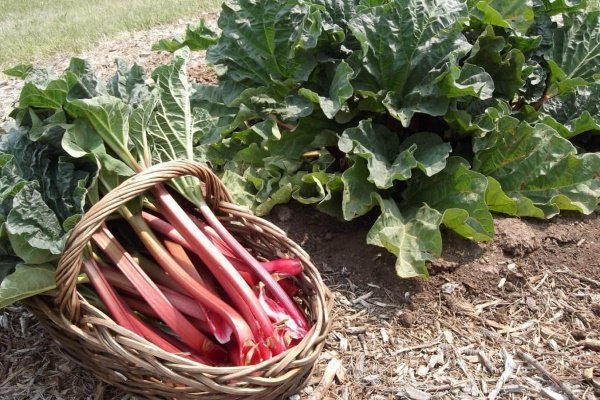

The healing properties and benefits of rhubarb
Tibetan medicine uses rhubarb for medicinal purposes the longest. In China and Tibet, this plant is included in the composition of many collections because of its ability to positively affect all body systems.
In our country, the following abilities of rhubarb are most appreciated.
- Effects on digestion. Rhubarb regulates appetite, contributes to the saturation of digestive juices with enzymes, and normalizes the acidity of the stomach. The plant can be used for gastritis and ulceration of the mucous membrane, as it promotes its healing. It is also used to treat any constipation, with intestinal weakness. The plant normalizes the intestinal microflora, eliminates the decay processes. Anti-inflammatory properties allow rhubarb to treat hemorrhoids, colitis, proctitis.
- Effects on the skin. Rhubarb whitens age spots and helps remove scars. The healing effect is actively used in the treatment of psoriasis, eczema, wounds, trophic ulcers.
- Antitoxic effect. Rhubarb preparations absorb poisons, toxins, and decomposition products. This ensures the plant's ability to eliminate intoxication of any origin. With the help of rhubarb, you can quickly overcome the hangover syndrome. The root is used in the complex treatment of hepatitis and poisoning.
- Fortifying influence. Rhubarb stimulates the immune system as well as hematopoiesis. The plant helps to put on their feet weakened patients who have had pneumonia, tuberculosis, anemia, large blood loss. It has long been known for the ability of rhubarb to cheer up and add strength. The plant is included in the diet for weight loss, as it improves metabolism.
- Hypoglycemic action. Rhubarb leaves (petioles) are good at lowering blood sugar, helping to maintain stable blood sugar levels in diabetics. They should eat fresh petioles.
- Anti-inflammatory effect. Rhubarb rhizomes are assigned the ability to relieve internal inflammation in diseases of the appendages, arthritis, gout.
In cosmetology, rhubarb is also highly valued for its antibacterial and healing properties.Infusion of the plant removes acne, vitiligo, acne, boils, various rashes. The recipes for use are very simple - they rub the affected skin with crushed petioles or plant juice. Alopecia is also among the cosmetological indications for use. The use of hair roots is due to the vitaminizing and tonic effect.
general characteristics
Many can be driven into a dead end by the question: "What is rhubarb: a vegetable or a fruit?" Botanically speaking, it is a vegetable, but its flavor and use in the kitchen bears more resemblance to fruit. In English speaking countries, rhubarb is called “pie plant” which translates as “pie plant”. And all because these stems, along with many berries and fruits, are often used by Americans as a filling for sweet baked goods.
The stems of this plant are very similar to celery stalks. But in rhubarb, they are not only bright green, but often with a raspberry tint. And their taste is very similar to the taste of green apples, and all because rhubarb contains malic acid (the same substance contained in apples and grapes).
It may sound strange, but rhubarb in the botanical pedigree is a relative of buckwheat and belongs to the buckwheat family. Rhubarb is a perennial plant that can live for more than 20 years under optimal conditions. But the concept of "optimal conditions" in the case of rhubarb does not mean that the plant requires particularly reverent care or whimsical to climatic conditions.
Biologists believe that the lands of Western China, Tibet, Mongolia and Siberia are native to this culture. Since ancient times, the dried root of the plant has been used in these regions. It has been used to treat a wide variety of diseases. But the powerful healing properties also affected the cost of the medicine, and not only in the East. For example, in France in the 16th century, rhubarb was 10 times more expensive than cinnamon, and in England in the 17th century - 2 times more than opium. But despite such popularity of the plant, Europeans began to eat it en masse only in the 18th century. Interestingly, at this time, rhubarb was used in the kitchen only for making drinks and as an ingredient in meat stews. By the way, due to the fact that rhubarb easily takes root in almost any area and grows quickly, for a long time it was considered a weed.
Only the stems of the plant are used for food. The leaves and root contain a lot of oxalic acid, which in large quantities acquires toxic properties. In particular, when ingested, this substance can cause kidney failure. And 19.2 g of oxalic acid is a lethal dose for a person weighing 50 kg.
Caveats
The multifaceted benefits of rhubarb does not mean that everyone can use it, and uncontrollably. The harm of rhubarb can manifest itself in people suffering from kidney stones and nephrolithiasis, since a side effect of the plant is the deposition of oxalate salts.
In addition, people with high acidity, stomach ulcers and cirrhosis of the liver should treat rhubarb with caution.
Contraindications for rhubarb include diarrhea due to the risk of continuation and dehydration as a result. In limited quantities, rhubarb desserts can be consumed by the elderly, while for children it is better not to use the plant. During pregnancy, as well as during breastfeeding, it is better to refuse any form of rhubarb.
Care
The plant is demanding on soil moisture, but it does not like waterlogging. Drought is also not good for him, as lack of moisture affects the size and taste of the petioles. With heat and lack of water, they stunted. On the table there will be thin, short petioles with a bitter taste. Regular watering, on the contrary, increases the yield and quality of the vegetable.
Fertilizers are applied in early spring - either mineral or organic, coupled with an ash solution. Once every three years, humus is introduced into the aisles.
Rhubarb is not afraid of frost. In winter, it tolerates severe cold temperatures down to -30 ° C. In spring it can withstand frosts down to -10 ° C, but on condition that the kidneys have not had time to "wake up". However, a comfortable temperature for him is 16-20 ° C heat.
In the second or third year, rhubarb begins to flower. They must be ruthlessly removed, otherwise the regrowth of the leaves will greatly slow down.
Procurement of raw materials
The healing properties of rhubarb are attributed not only to its roots, but also to the stalks. For a variety of harvesting, you can use a young plant. In the case of collecting old leaves, the top layer is peeled off the petioles. Rhubarb can be frozen, dried, and canned in a variety of ways.
Dried roots
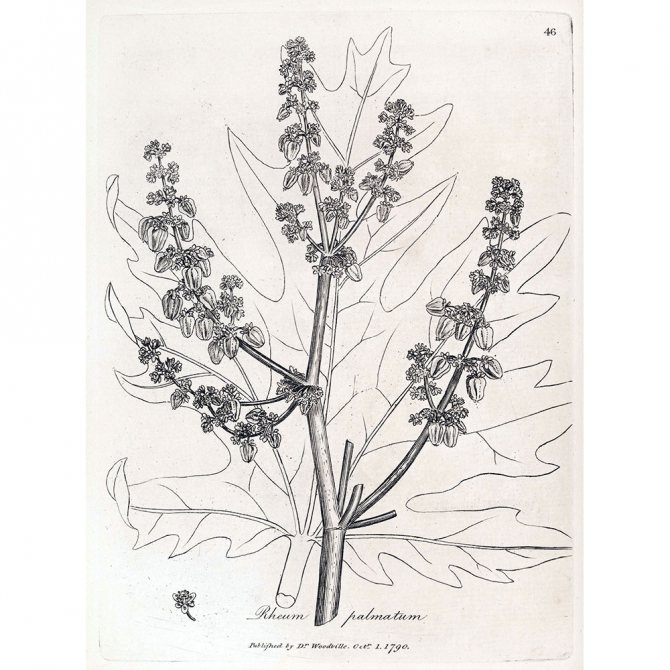

Finger rhubarb. Botanical illustration from the book "Medical botany" by William Woodville (1752-1805), 1790.
Features. Traditional medicine uses rhubarb roots and rhizomes dried immediately after harvest. For the procurement of raw materials, only plants that have reached the age of four are suitable. It is during four years that the maximum accumulation of nutrients occurs.
Procurement stages
- Harvesting begins in September and ends in mid-October. The plant is dug up with a shovel, trying to drive it as deep as possible into the ground. After that, the bush is pulled by the root rosette in order to gently and carefully pull the long roots out of the soil.
- The aboveground part is cut off from the underground part. Roots and rhizomes are well shaken off from the soil, dry and rotten parts are cut off, washed with plenty of cool running water. The roots are cut into pieces about 10 cm long, after which they are laid out in a shaded place in the air to dry out the remaining moisture and slightly wither.
- Dried roots are laid out in dryers, the temperature is set to 60 ° C. Dry until the raw materials are completely dry.
With proper collection and drying, the result is dried roots with a dark brown surface and a yellow-pink, granular core, with a specific odor and an astringent-bitter taste.
Freezing
Features. In order to preserve all the useful properties of the petioles, it is important not to subject them to heat treatment. To preserve the color of the product, it is recommended to blanch the petioles in boiling water. But this procedure significantly reduces the beneficial qualities of the plant, therefore, if you want to preserve the benefits of the product, it is better to refuse it.
Procurement stages
- Petioles together with leaves are cut off from the underground part. Having collected in a uniform bundle, the sheet plates are completely chopped off.
- The petioles are washed with cold water. Dry from excess moisture by spreading them out on paper towels. Cut into cubes, spread in one layer on a wide baking sheet.
- A baking sheet with cubes of rhubarb stalks is placed in the freezer for one hour, after which the raw material is poured into a plastic bag, excess air is squeezed out of it, tied with an elastic band and placed in the freezer for storage.
Frozen rhubarb can be used to prepare medicines, compotes, jelly, fillings in baked goods, add to soups.
Dried petioles
Features. You can prepare rhubarb leaves for the winter, while preserving its beneficial properties, by drying. Shredded dry petioles are used in cooking and medicine. They enrich the taste of salads, pastry baked goods, and are added to sauces.
Procurement stages
- The leaves are chopped off from the underground part of the plant. Collect in a bunch and completely remove the leaf plates, getting clean red petioles at the exit.
- The petioles are washed with running water, cut lengthwise into several parts.
- It begins with drying the petioles in the open air. To do this, they are laid out on a pallet lined with paper or cloth in one layer. Place the pallet in the open sun. Dry for two days.The dried petioles are folded on a baking sheet in a thin layer and dried in the oven for two hours at a temperature of 90 ° C. Dried raw materials are stored in glass jars whole or after grinding.
Reproduction by dividing the rhizome
Only 5-year-old bushes are suitable for this method. They must be carefully cut into pieces with a sharp knife. Each should have 1-2 large buds and a well-developed root system. Preference should be given to those "eyes" that are on the periphery. Plants obtained from central buds tend to emit peduncles.
Rhizomes are planted in late August or in spring. They are planted in pits 30 by 30 cm, into which compost and garden soil are filled. They are planted flush with the ground, keeping a distance of 70 cm between them. The soil is tamped and watered. The buds are sprinkled with humus with a layer of 1.5-2 cm.
You can propagate a culture with a rhizome and without buds, but then you should not expect a quick regrowth of the petioles. In this situation, the development of the plant will be very slow.
Delicious preserves
The beneficial properties of rhubarb for the body during its conservation are manifested in the form of a tonic, tonic, improving digestion action. Rhubarb is used to prepare marmalade, wine, and various sweet and sour sauces. For the preparation of medicines at home, dried roots are used, as well as dried and frozen petioles.
Stalk compote
Features. To make a delicious rhubarb compote, you can add apples, raisins, citrus fruits, cinnamon, cloves, vanilla sugar. The amount of sugar, fruit, stalks and spices can be varied to your liking.
Preparation and application
- Petioles peeled from leaves are washed with running water.
- The petioles are cut into cubes, poured with cold water for 20 minutes, to compact their structure.
- Water is boiled in a saucepan, sugar is poured at the rate of half a glass of sugar per liter of water. Additional ingredients and rhubarb are added.
- After a weak boil for half an hour, the compote is poured into prepared jars, rolled up with lids.
Juice and candied fruits
Features. These blanks are made at the same time. The result is two healthy and tasty products.
Preparation and application
- The leaves are cut from the rhizomes. Petioles and leaf plate are separated.
- The petioles are washed with cold water, dried, cut into pieces.
- Sprinkle the cut stalks with sugar. Placed under the press for a day.
- The released juice is drained, boiled and rolled into sterilized jars.
- The petioles are laid out on a baking sheet covered with parchment, placed in the oven to dry at 60 ° C. Ready candied fruits should be stored by placing them in linen bags.
Jam
Features. The remedy is contraindicated in diabetes, it is given with caution to children due to its high sugar content. Perfect for adding to tea, baked goods, to maintain body tone in the cold season.
Preparation and application
- Petioles are separated from the underground part and leaf plates, washed with cold water.
- The petioles are cut into cubes, covered with powdered sugar overnight, observing a 1: 1 ratio.
- In the morning, the resulting mixture is brought to a boil. Add the rosemary branch and cook for ten minutes.
- Jam is poured into prepared jars, rolled up.
The jam will taste interesting if you add bananas, citrus fruits or spices.
Pride of the British Empire
The story of rhubarb is an intriguing series of ups and downs, love and indulgence, and in the finale - a well-deserved nationwide recognition. The healing and tasty rhubarb was discovered, as it should be, by the Chinese - noble healers. For many centuries, Asians enjoyed an unusual vegetable, then the Arabs picked up the baton and decided to share the find with the Europeans - of course, enlightened humanity, but they don't know such a miracle!
The Europeans did not appreciate the gift: well, useful, so what? We have over there, red currants, sweet carrots and fragrant herbs, one dill is worth something! But several centuries have passed, and the situation has changed dramatically. In Europe, medicines and culinary delights with rhubarb became fashionable, and in Siberia, on the sly, they began to actively grow a green vegetable and ship it through St. Petersburg to the Old World. Yes, so actively transport that the enterprising Peter the Great introduced a state monopoly on rheum production - and the Russian treasury was well replenished from this.
Today, you can find tasty herb in many places, from the Himalayas to Israel, - rhubarb grows everywhere (Wikipedia is picky about geography). But the main connoisseurs of the product are the English-speaking countries, Britain and the United States. In Yorkshire, for several generations in a row, a vegetable has been grown according to all the rules - no windows and bulbs in greenhouses (tender rhubarb needs darkness), and they harvest, as in the Middle Ages, with a candle light ...


Medicinal use
The use of rhubarb also implies self-preparation of medicines.
Infusion for constipation
Features. Rhubarb can be addictive to the body. Therefore, using it as a laxative, it is better to alternate such an infusion with pharmaceutical preparations.
Preparation and application
- Two tablespoons of dried rhizomes are thoroughly pounded in a mortar.
- Pour raw materials with a glass of boiling water.
- Insist for 10-15 minutes.
- Strain, drink a third of the drug before bedtime.
Diarrhea powder
Features. Rhubarb powder is equally active against diarrhea and flatulence, intestinal cramps, and dysbiosis.
Preparation and application
- The dried roots are ground in a coffee grinder to obtain a powder.
- Consumed inside at the tip of a knife with water. The frequency of admission per day is two times. To improve the taste, the powder can be mixed with honey.
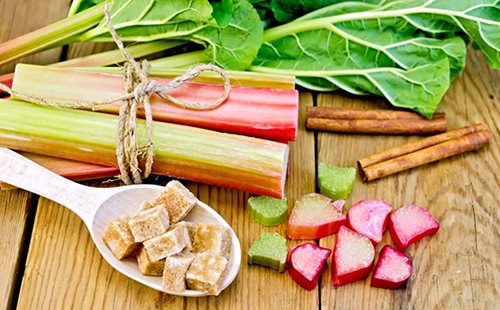

Decorative varieties
If you want to grow rhubarb in garden design, then you should choose decorative plant forms:
- "Atrosanguineum" with dark purple leaves on young shoots, which gradually turn into a rich green with cherry petals.
- "Victory" with large leaves, collected in a rosette, which reaches 100 cm in diameter. Petioles are red at first, then turn green with a pink base.
- "BowlesCrimson" - red flowers and the lower surface of the leaves.
- "Cyclops" with specks on the upper part of the leaf and intensely colored cuttings.
- "Moskovsky-42", with large smooth leaves with wavy edges.
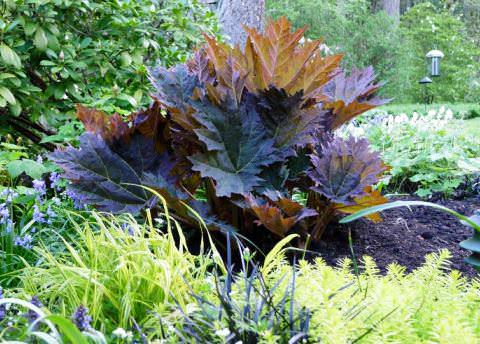

- "Giant" with very long petioles and "Tanguticum", which has a purple tint of foliage.
About pests
Rhubarb, like all vegetable crops, can be affected by pests, in particular, rhubarb bug, potato scoop, beetles and larvae, as well as aphids. To get rid of them, plants should be sprayed with an aqueous solution of tobacco dust at the rate of 4-5 g per 1 m².
Another main enemy of this vegetable crop is powdery mildew. This viral disease is typical for areas with a humid climate and affects many vegetable crops. The best remedy for powdery mildew is spraying the plants with a 1.5% solution of Bordeaux mixture.
To achieve the goal of protecting rhubarb from pests and viral diseases, preventive soil treatment with a weak manganese solution or Bordeaux mixture is recommended.
It does not matter which drug is chosen to protect the rhubarb from possible diseases and pests, for the labor spent, the rhubarb will generously "thank" the gardener with tasty, juicy and very useful petioles.
Altai dawns
The plant is a sprawling bush with powerful petioles of intense red color. The Altayskie Zori variety is suitable for growing in all regions of Russia.
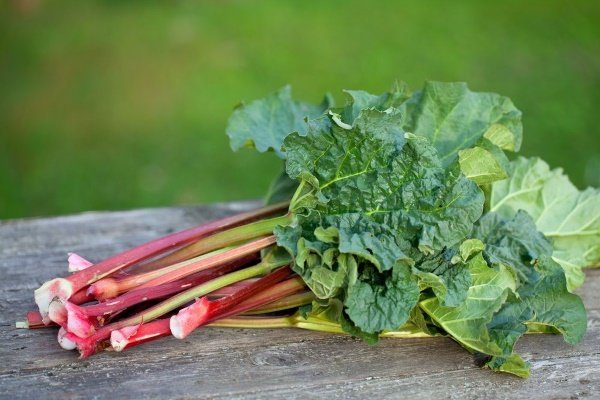

Characteristics:
- petiole length - up to 70 cm;
- weight - 80-120 g;
- the taste is sweet and sour;
- yield during the growing season - about 4.2 kg per 1 sq. m;
- early ripe variety: the first petioles can be harvested in 23 days - in such a short time, the fruits reach technical maturity.
Benefits:
- high yield rates;
- high commercial qualities;
- disease resistance;
- frost resistance.
Side effects
As a food item, rhubarb is considered safe without causing side effects. But at significant therapeutic doses, it can cause problems.
The risk of side effects increases if rhubarb preparations - infusions, decoctions, etc., are taken for more than 8 days. Long-term treatment with rhubarb threatens:
- violation of the heart rhythm;
- the formation of kidney stones;
- back or abdominal pain;
- dizziness;
- irritation of the skin and mucous membranes;
- tenesmus (unsuccessful urge to urinate / bowel, accompanied by soreness);
- vomiting;
- diarrhea;
- rush of blood to the pelvic organs.
Popular types
Noble
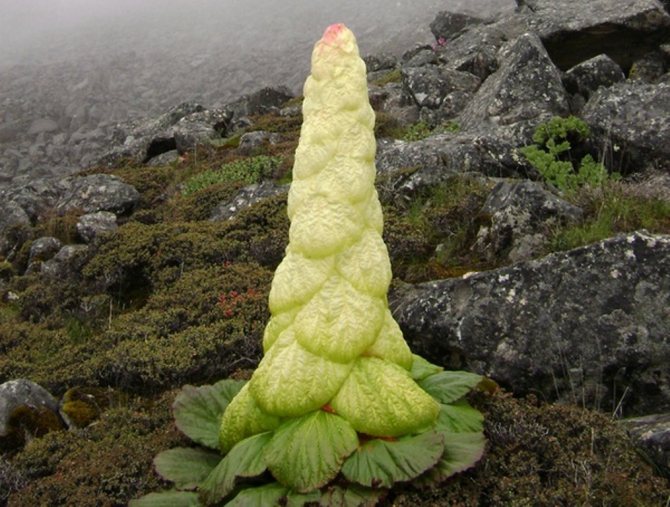

noble rhubarb
Herbaceous perennial, grows up to 2 m. The root system is fleshy, the leaf plates are large, the stems are powerful.
Tangut
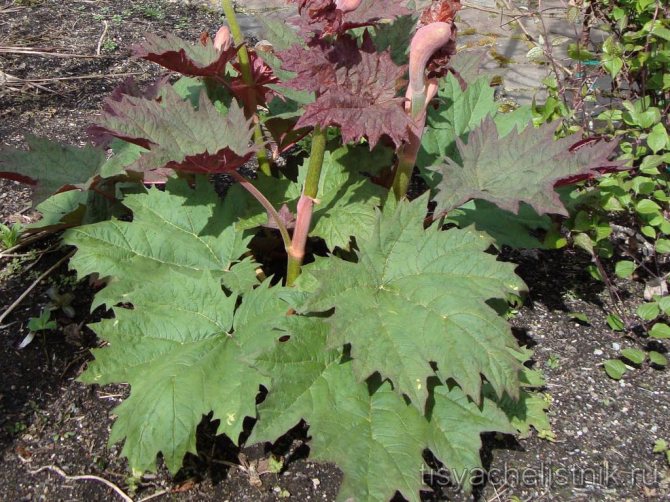

rhubarb Tangut
Large herbaceous perennial. The roots are fleshy, extending from a short rhizome, the leaf plates are large.
Leader
This perennial variety of rhubarb produces thick, very juicy petioles with delicate flesh. They are suitable for preparing various dishes, including desserts and compotes.
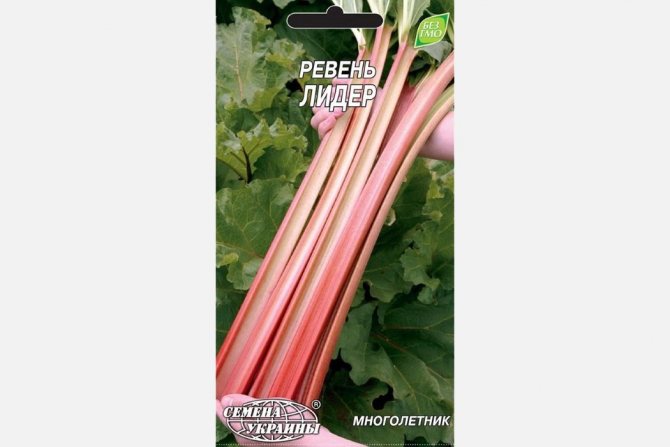

Characteristics:
- petiole length - 35-50 cm;
- average weight - 25-50 g;
- taste - sweet and sour;
- yield - from 2 to 5 kg per 1 sq. m;
- mid-season variety: the crop is harvested 30-45 days after the first shoots appear.
Benefits of Rhubarb Leader:
- composition rich in vitamins and minerals (pulp contains potassium, phosphorus, magnesium, vitamins A and C);
- cold resistance (tolerates frosts in spring up to -10 degrees);
- unpretentiousness to light and soil composition.
Obsky
Perennial with delicate pulp, the fruits of which are used for processing, making jam and compotes. The variety is suitable for growing throughout Russia.


Characteristics:
- petiole length - 22-23 cm;
- average weight - 44-84 g;
- taste - sweet and sour;
- low yield - 1.6-2.1 kg per 1 sq. m;
- mid-ripening variety: technical ripeness occurs 30-39 days after the emergence of full shoots.
The advantages of the Obsky variety:
- frost resistance;
- high decorative qualities;
- waterlogging resistance.
Growing problems
When growing rhubarb, there are other problems: frequent flowering, yellowing or reddening of the leaves.
Rhubarb often blooms
Flower arrows prevent the development of young growth, worsen the quality of the petioles, so they must be removed.
What could be the reason for the constant flowering of rhubarb? First of all, you need to pay attention to the correct choice of mother plant for vegetative propagation. You should not take a division with a central root shaft for propagation of rhubarb. A big mistake will be the use of a bush older than five years as a planting material. When choosing a part of the rhizome for dividing, pay attention to the number of buds: there should not be more than three or four of them, otherwise rhubarb will bloom quickly and often.
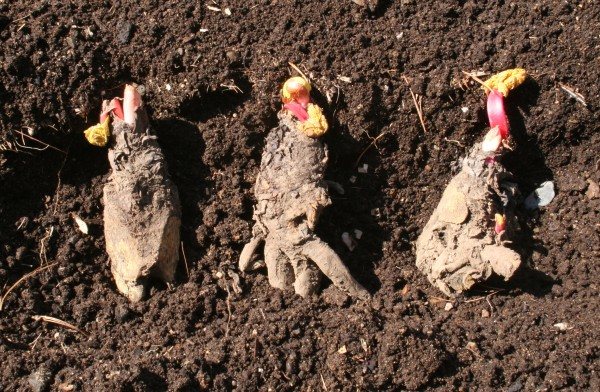

Rhubarb rhizome segments for division should have no more than three or four buds
If the plant is constantly blooming, despite the removal of peduncles, it may be too old, or it may be overfed with phosphorus fertilizers, which are applied after each petiole harvest.
Video: how to cut peduncles from rhubarb
Leaves turn yellow or turn brown
Sometimes yellowing of the leaves is observed in rhubarb. They turn pale, develop poorly. The reason for this is the lack of nitrogen in the soil. It is necessary to feed the plant with ammonium nitrate, an aqueous solution of mullein (1:10) or bird droppings (1:20).On nitrogen-poor soils, fertilizing with nitrogen fertilizers is done several times, using them in small doses (1 tablespoon per bucket of water).
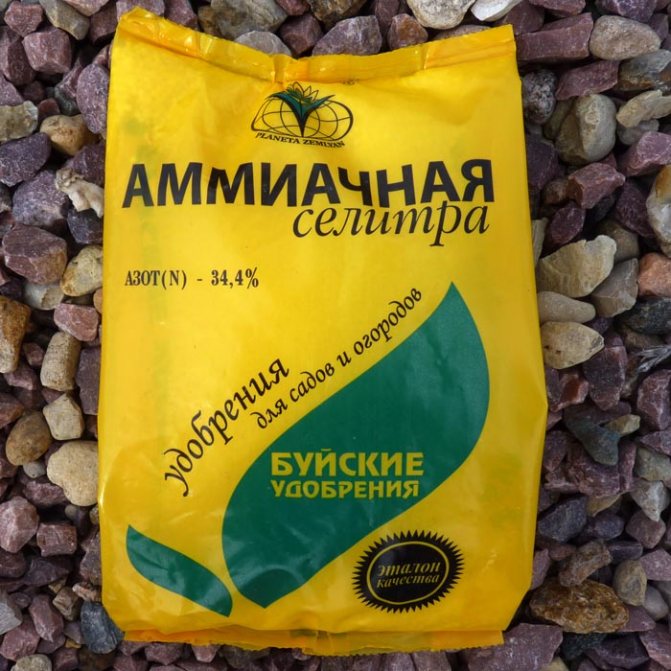

Of nitrogen fertilizers, ammonium nitrate or nitrophoska is suitable for rhubarb
Often the leaves turn red or brown, which is also a consequence of nitrogen starvation. Attention should also be paid to the planting density. On too thickened rhubarb beds with leaves, the same "metamorphosis" can occur.
Indications for use
The benefits of rhubarb are undeniable. Experts often recommend taking it for prophylactic or therapeutic purposes. An ophthalmologist can recommend the product to patients who complain of eye health. Its regular use in food prevents glaucoma and cataracts, and also helps relieve tension, strengthen muscles and produce natural tears.
See also
How to treat aphids on beans, other legume pests and control measuresRead
The gastroenterologist insists on taking it for gastritis caused by low acidity. Daily use increases the secretion of gastric juice and successfully fights unpleasant symptoms.
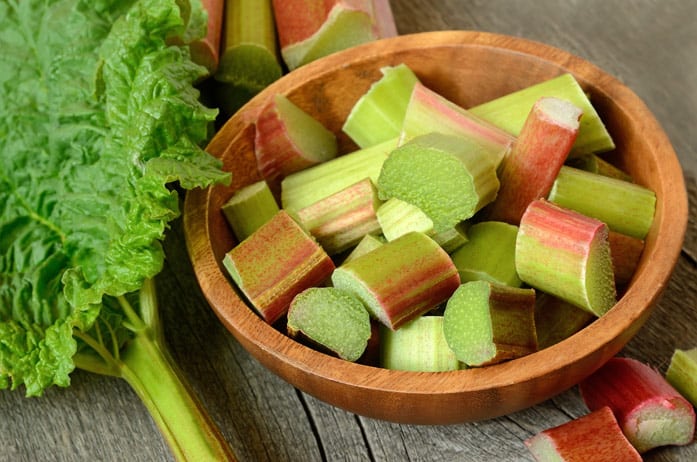

The vegetable can improve blood composition. The product is effective in preventing blood clots. In addition, it will be useful for people suffering from atherosclerosis and thrombophlebitis. It is also suitable for patients whose problems are associated with varicose veins. Cosmetologists note the positive effect of the plant in the fight against age-related skin changes. Its topical application enhances collagen production, which helps to cope with the signs of wilting.
Red late 34
This variety of rhubarb is appreciated not only for its abundant harvests, but also for its decorative qualities. He received the name for the corresponding ripening period, as well as the rich scarlet color of ripe petioles.
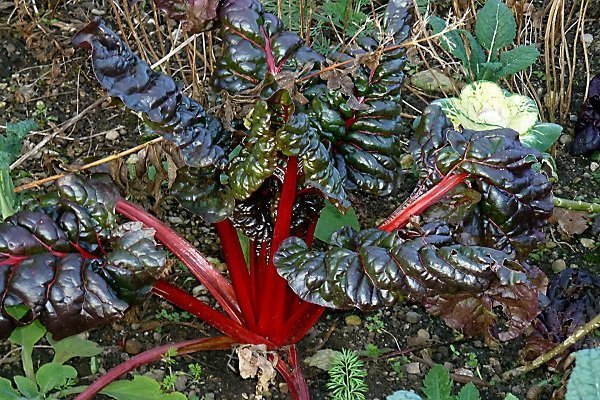

Characteristics:
- petiole length - from 40 to 70 cm;
- weight - up to 160 g;
- taste - sourish, with notes of sweetness;
- yield - from 1.9 to 7.3 kg per 1 sq. m;
- late-ripening variety: the crop is harvested 65-69 days after germination.
Benefits:
- high content of vitamins and microelements, due to which it is widely used in folk medicine;
- decorative properties (the bush is tall, the leaves shine with gloss, have a purple tint);
- disease resistance;
- versatility in cooking.

